#Appendix J
Text
Started crying over the Batman Beyond Animated Movie concept art. I am so normal.
#do they want my left or right kidney? they can have that one and my appendix as I don't need those to survive#I'm saving my uterus for Silksong if it needs more funding. I'm not gonna use it so might as well.#/j#about selling my organs not about crying over Batman Beyond Animated Movie#I think a Batman Beyond Animated Movie could fix me. Or make me even more autistic about it. probably both.#Batman Beyond is what got me into Batman. it was the only Batman related thing my library had and I thought it looked cool#so I would just watch Batman Beyond for like 5 hours minimum every day during my surgery recovery#so if you're wondering why I am like this...that's why. Batman Beyond did it. it's still my comfort media and i always go back to it#THAT ONE IMAGE OF INQUE CHASING TERRY?? OH MY GOD IT'S SO GORGEOUS#oh my god I am so ordinary and neurotypical#THE FUCKING PRODUCTION DESIGN GUY ON SPIDERVERSE POSTED THEM??#sav eme Batman Beyond Animated Movie#it will fix me I promise#if it is made I will forgive Bruce Timm for his weird thing for Batman x Batgirl.#SPIDERVERSE OF BATMAN MOVIES?? OH MY GOD#Derek Powers on my movie screen#THE SHIT THEY COULD DO WITH SHRIEK??? HOLY FUCK#I hope to god they still have the cold open on old-man Batman (world-weary and brittle-boned) almost shooting somebody in a panic#because THAT is the only compelling reason I have ever seen for Bruce leaving behind the mantle#I love content where its like 'oh when he gets older he becomes the Alfred to a new Batman' or 'he'll retire because Gotham will be better'#but I'll be honest. I do not think Bruce is capable of retirement. I do not think he would ever hang up the mantle willingly#unless he almost became the very kind of person who got his parents killed: a gun-wielding coward. the pain in his eyes.#I could see that. Bruce realizing that he is incapable of being Batman. That he will do more harm for Gotham than good.#if they don't want it to be the opener that's fine. but I want that damn scene.#ajdfl;dksajfl;kjdsfl;kadjskl;fjds Terry my friend Terry on my movie screen#I am going to explode
5 notes
·
View notes
Text
"Yet there may be a light beyond the darkness; and if so, I would have you see it and be glad"
J. R. R. Tolkien - The Lord of the Rings
#appendices#appendix A#the tale of Aragon and Arwen#aragorn#arwen#the lord of the rings#j r r tolkien#j. r. r. tolkien#tolkien#the return of the king#gondor#strider#thorongil#light#darkness#hope#estel#faith
11 notes
·
View notes
Text

In 2509 Celebrian wife of Elrond was journeying to Lórien when she was waylaid in the Redhorn Pass, and her escort being scattered by the sudden assault of the Orcs, she was seized and carried off. She was pursued and rescued by Elladan and Elrohir, but not before she had suffered torment and had received a poisoned wound. She was brought back to Imladris, and though healed in body by Elrond, lost all delight in Middle-earth, and the next year went to the Havens and passed over the Sea.
J.R.R. Tolkien: The Lord of the Rings; Appendix A – 'Annals of the Kings and Rulers'.
Illustration 'Leonore' by W. Heath Robinson.
Published in: The Poems of Edgar Allan Poe. London/ New York 1900.
Edited and cropped by me.
#j. r. r. tolkien#quote#celebrian#elrond#w. heath robinson#the lord of the rings#tolkien#lotr#lotr appendix a#illustration
36 notes
·
View notes
Text
No one talks about how traumatic appendicitis really is.
After my friend got his appendix removed he asked the doctors if he could keep it and they LITERALLY said NO.
That is THEFT. They STOLE his appendix.
WHAT DO THEY EVEN WANT IT FOR? HMM?
According to JESUS, the only doctor who’s ever cured crucifixion, thievery is a SIN.
SEE YOU IN HELL “DOCTORS”.
14 notes
·
View notes
Text
James Jacksonville redraw @fl33tway-sup3r-s0n1c

reblogs > likes
#alucard's art#art#artists on tumblr#alphabet lore#alphabet lore j#j#alphabet lore appendix au#alternative universe#jaguar#redraw
13 notes
·
View notes
Text
I do gotta say tho and I think i've talked about this before but a ttrpg design dream of mine is to basically make an SRD which doubles as a textbook for several applied sciences and gather a team of world-class rules lawyers and just go, Godzilla is rising from the sea in 30 days, good luck
#for the tactile strength of reptile scales see page 624. for the conversion formula from newtons force to hp damage see appendix J.#for the frontal surface area of an average forklift see supplementary document V-C05
2 notes
·
View notes
Text
yes I do think it's incredibly funny that the PPR character I gave the alias apollo has powers of prophecy why do you ask
#rambles#yes this applies to everyone. when his stand is active if you say the wrong thing around him it becomes inevitable#he could literally go ' hey wouldnt it be funny if your appendix failed ' and it would /j
6 notes
·
View notes
Text
ohh anti nausea meds our love hate relationship rivals that of ********
#i havent had t take them in a while#but i feel awwwufl. pribably bc ive been on my puter alld ay which kills the man#but oguggggj.#whateverr. maybe coffee icecream will help smiles.. ik im lactose intokerant but coffee icecream makes em feel bette usually#i used t have t take anti nausea meds allll th time tho#b4 i had ny appendix out. n then it gt better#but its gettin badd again the nausea i mean.#maybe i have appendicitis again 🤤 /j#But they taste so bad#and its even worse bc yiu cn tell they Knew theyd taste bad so they put th bad strawberry (???) flavor#but it makes it worse. AND they arent swallow thinngs th ones i take you have to let them dissolve on yr tongue#but they taste bad . which makes it difficult
3 notes
·
View notes
Text
Changes to 10-Year Long Residence Indefinite Leave to Remain
Since 11 April 2024, a significant update has been made to the UK Immigration Rules with the introduction of Appendix Long Residence. This new appendix outlines the Long Residence indefinite leave to remain (ILR) route, which allows individuals who have lawfully and continuously resided in the UK for 10 years or more to apply for settlement. This article delves into the details of these changes,…
#10 Years Long Residency#Absences#Absences from UK#Appendix Continuous Residence#Best Immigration Solicitors London#Continuous Residency#David J Foster & Co Solicitor#DJF Solicitors#English Language Requirement#Home Office#Home Office Updates#Immigration Policy#indefinite leave to enter#Lexvisa#Life in the UK Test#london#London Immigration Solicitors#Settlement#Solicitors#UK Immigration#UK Immigration Advice#UK Immigration Policy
0 notes
Text

J. R. R. Tolkien, The Return of the King (1955), Appendix A, "Durin's Folk"
#the lord of the rings#tolkien#lotr#quote#gandalf#saruman#dáin ironfoot#thorin oakenshield#x.#litblr#firstly: 😭#secondly: it is my chosen belief that this is what radagast is busy with throughout lotr
81 notes
·
View notes
Text

For many years, I've carried a pocket notebook in which I inscribe daily musings, documentary information, grocery lists, etc., etc. These informational notes find their way into the art journals that are most often completed back home in my studio. Fully completed notebooks are archived in handmade book boxes.
Gerard Lange art journals, Appendix J, Notebooks (book box), hosing daily and event-specific notebooks, 30.5 x 22.5 x 12.5 cm (12 x 8⅞ x 5 in.).
#art#artjournals#artistjournals#artjournalspread#artprofessor#artteacher#collage#commonplacebooks#creativejournal#gerardlange#gerardlangeartjournals#journal#journals#journaling#junkjournal#mixedmedia#notebooks#scrapbooking#sketchbooks#fieldnotes#moleskine#waverly#waverelybooks#tartan
76 notes
·
View notes
Text

A is for Arsenic defines and explains the basics of Victorian mourning traditions and objects, digging up the truth about tear bottles, post-mortem photography, and poisonous mourning veils, using anecdotes, macabre stories, and even jokes from the Victorian press. The book also debunks several Victorian mourning myths. Each entry includes an evocative pen and ink illustration by award-winning artist Landis Blair. There are 26 alphabetical entries―from Arsenic to Zinc, along with an informative glossary, appendix, and detailed bibliography. A – Arsenic; B – Bier; C – Crape; D – Death Token; E – Embalming; F – Fisk Burial Case; G – Gates Ajar; H – Hearse; I – Ice Box; J – Jet; K – Keen; L – Lychgate; M – Mute; N – Necropolis; O – Obelisk; P – Post Mortem; Q – Queen Victoria; R – Resurrection Men; S – Shroud; T – Tear Bottle; U – Undertaker; V – Veil; X – Sexton; W – Weepers; Y – Churchyard; Z – Zinc
https://amzn.to/3zeu1aa
20 notes
·
View notes
Text
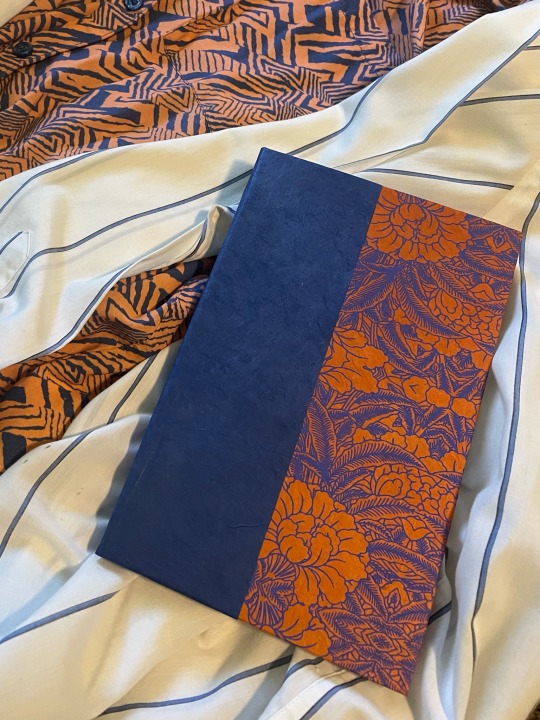

Ficbind complete for a Disco Elysium fanfic I was absolutely delighted to find, because it’s illustrated!
The Long View Down by Rin/kriegersan on AO3 was a well-written continuation of the game with the new perspective of the NPC no one wants to disappoint: Lieutenant Kim Kitsuragi. It reads like a noir book and I tried to keep it flimsy like noir often is, but I did use some of this bright orange handmade paper for a book of my own (I used it for a book I was sending to my friend that's in a completely different fandom—handmade paper is the gift that keeps giving and giving and giving...).

Couldn’t resist taking it to the toilet, where Harry belongs.
I’ve followed J. R. Doyle’s comics and illustration work since the early days of Knights Errant and absolutely love their style. It fits in so well with the dark storyline, and had the bonus of being black-and-white already so I could still print it successfully!
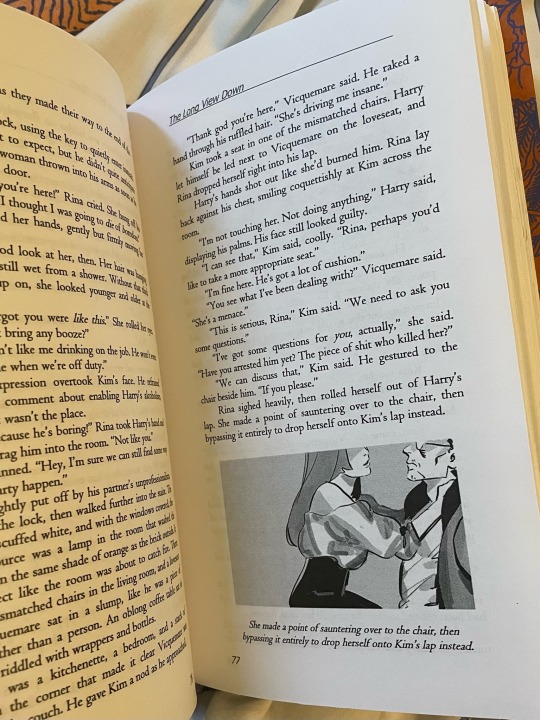
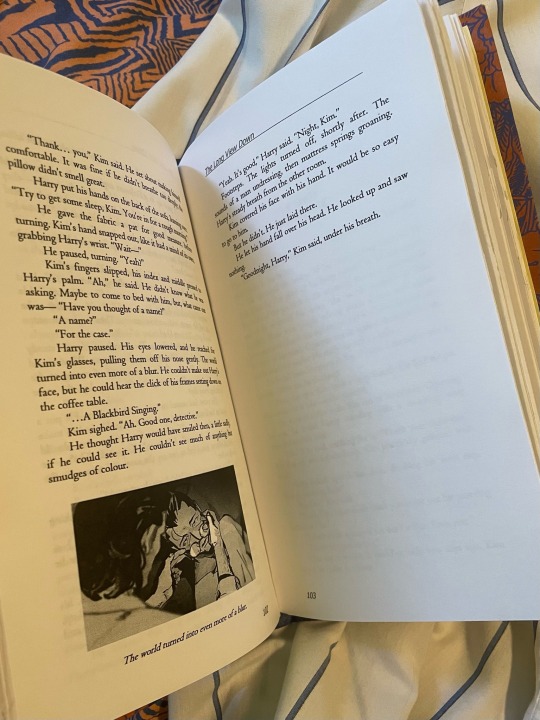
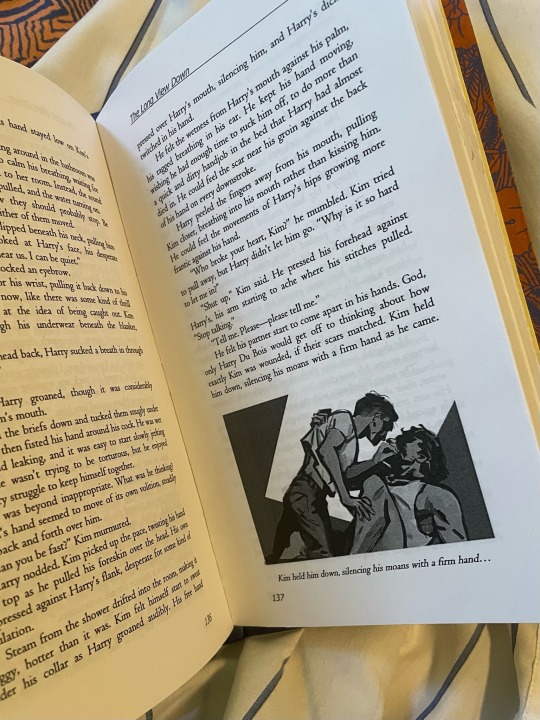
I went for a kind of old-fashioned way of including the illustrations—I added quotes from the text under the pictures, as I perceived them fitting into the story. I had an appendix of the illustrations and quotes at the end of the book.
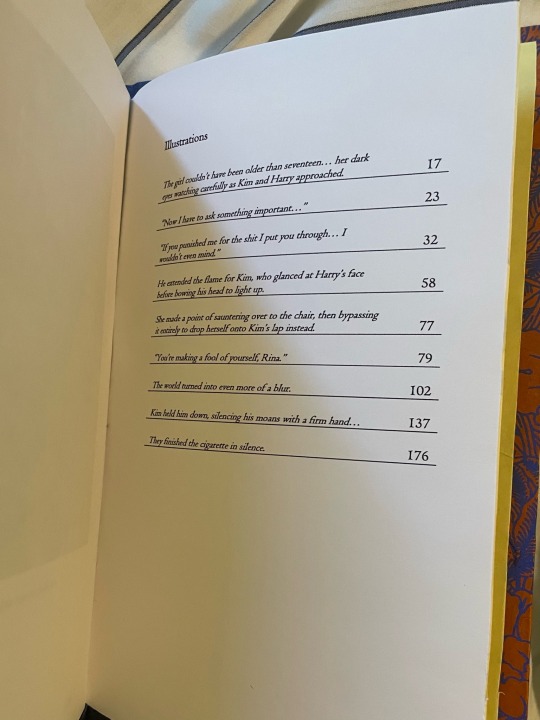
I collaged the title page out of illustrations throughout the story. The summary lines are there, too, set up in the style of trashy paperback bodice-rippers. I’m pretty proud of this one, in spite of the flaws I see! I’m going to see if a friend wants to read it. I feel like a lot of Disco Elysium stories stand well on their own, with their mystery plots and otherworldly setting. I might be biased, though; I loved this game.
33 notes
·
View notes
Text

Morwen of Lossarnach, also called Steelsheen, descended from the Princes of Dol Amroth and became Queen Consort to King Thengel of Rohan. Unfortunately Tolkien doesn't say much about her.
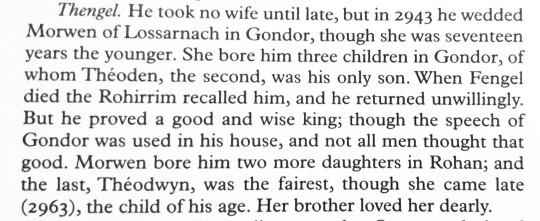
Besides this quote Tolkien writes that Éowyn bears a resemblence to her grandmother Morwen and their shared Gondorian ancestry.
J.R.R. Tolkien: The Lord of the Rings, Appendix A, the House of Eol.
Illustration by W. Heath Robinson.
Published in: The Poems of Edgar Allan Poe. London/ New York 1900.
#tolkien#j. r. r. tolkien#lotr#the lord of the rings#quote#thengel#morwen of lossarnach#morwen steelsheen#lotr appendix a#gondor#eowyn#w. heath robinson#illustration#rohan#house of eol#women in lotr#women in tolkien's writing#women in tolkien's universe
6 notes
·
View notes
Text
This is a VERY long text post.
thanks @squareallworthy for giving me the excuse to make a House of Leaves post!! I'm going to try to make this accessible to everyone, so:
If you haven't read HoL, feel free to bail if this goes too deep or stops making sense. Personally, I don't think you need to worry about spoilers because it's not that kind of book (it usually spoils itself anyway), but if you'd rather go in knowing nothing, slam that J key now.
If you have read HoL, feel free to skip ahead to the theories. You're presumably good at tuning out extraneous information by now. :)
What is House of Leaves?
House of Leaves is a novel by Mark Z. Danielewski (MZD), published in 2000. It's an example of postmodern literature, which according to Wikipedia is:
a form of literature that is characterized by the use of metafiction, unreliable narration, self-reflexivity, intertextuality, and which often thematizes both historical and political issues.
...all of which is House of Leaves to a T. Rather than capturing a single narrative, the book's text layers multiple stories, which refer to both each other and to external (e.g. mythical) stories, and which often reference the fact that they are stories in a book.
You can find it archived here, though unfortunately that scan/OCR seems to mangle the text in ways that will be hard to distinguish from everything else it's got going on.
Overall, I think the book is really cool and interesting, but maybe not worth sinking a ton of time and effort into. It's not a fun or easy read. Definitely worth checking out, but don't be afraid to skim or abandon it if it's not your thing.
The layers of HoL
The innermost layer is The Navidson Record (TNR), which is ostensibly a documentary but effectively a found-footage horror film. It's a series of films about the Navidson family--an unmarried couple with two young children--moving into a house in Virginia, and discovering that something is very strange about it. First subtly and then dramatically, the interior of the house grows and changes, in defiance of physical laws. One closet in particular becomes an eerie and seemingly infinite labyrinth, which they explore at their peril. (Don't worry--the overall novel is creepy and sometimes upsetting, but not outright scary. I'm a weenie about horror and had no trouble.)
The next layer is a pseudo-academic text about TNR by a blind man named Zampanò. He recounts the events of TNR, but also meanders on long tangents about other stories or academic works.
The third layer is the primary one we experience as the book House of Leaves. A character calling himself Johnny Truant discovered the disorganized and incomplete manuscript in Zampanò's apartment after that man's death, and he has assembled and edited it into this book, as well as added an introduction and lengthy footnotes relating stories from his own life. Johnny often contradicts himself, freely admits to making things up or changing the previous layers to suit his whims, and appears to mentally deteriorate over the course of the novel. He also says he can't find any evidence that TNR actually exists.
There's a thin layer added by "the Editors," who supposedly received the text from Johnny, and published it while in contact with him. They add some appendices and minor notes throughout, mainly to provide English translations for certain excerpts or to state that something the text refers to is missing. They include a purported still frame from TNR in the appendices, with no comment from Johnny.
All of the above, of course, was actually written by MZD, the real-life author of HoL. He self-published the earliest version of HoL to the internet, before publishing the full version as a physical book. He also produced some teleplays related to the work, and a collection of letters from Johnny's mother. The letters were originally published separately, but now most of them are included as an appendix to HoL. MZD's sister, the singer-songwriter Poe, also released the album Haunted around the same time as HoL, and it serves as a companion or counterpart to the novel.
The final layer is us, the readers. We interact with the text and also with each other, like I'm doing with this post. MZD's website still hosts forum threads from the time the book came out, where readers deciphered and theorized about it together. This is an important and intentional aspect of the work, as I'll explain in more detail later (see "The Meta").
Sub-stories
There are a few smaller anecdotes within the text which almost serve as their own layers, but don't fit neatly into the hierarchy above:
The Chiclitz play The Minotaur, on p110-111
The story of The Atrocity, on p297-300
The story of the changeling/cyanotic child, on p518-521 and referenced obliquely on p48-49
Themes and motifs
A non-exhaustive and highly subjective list, ordered very roughly from the most to least prominent:
The Greek myth of the Minotaur and the labyrinth
House
Madness, memory, and meaning
The sea and the sky
Darkness, absence, emptiness
Yggdrasil, the world tree; trees, leaves, and paper; the Cumaean Sibyl
Fidelity (in multiple senses of the word)
Colors, especially red/blue or red/blue/green/yellow
Death and rebirth, procreation, the womb
The biblical myth of Abraham and his sons
The biblical myth of Jonah and the Whale
The eye, cameras
Head injuries, holes in the head
Families, especially parents and twins/pairs of siblings
Note that there are connections and overlap between these themes. I'm going to argue that the first few in particular are strongly intertwined.
The Meta
Most of the fan theories I've seen are focused on the usual concerns: "what do you think really happened in the story? what does this mean for the characters?" That's reasonable, but since HoL is extremely aware of itself and its readers, I think it's also worth asking what the text expects from us or what it's trying to communicate directly, if anything. IMO those questions are easier to answer than nailing down the events of the story, and that's on purpose.
While rightfully regarded as a challenging and puzzling book, HoL actually is pretty blatant about helping us "solve" most of it. Heck, it color-codes its major motifs. There were many instances where I was like "oh, this reminds me of that other part from a ways back" and then the footnote would tell me to refer back to that part I was remembering. When there's an encoded message, like the Morse code or first-letter sections, Johnny typically makes a comment providing the key to decoding it--and in some cases also tells us the "hidden message," like in his conversation with the band near the end of the book.
The book straight-up tells you how to read it. On p115, just before it starts getting really wild with the typesetting in a section structured like a maze, Zampanò's text gives this advice for navigating mazes:
In order to escape then, we have to remember we cannot ponder all paths but must decode only those necessary to get out. We must be quick and anything but exhaustive.
The next footnote (139) also warns: "[in a maze,] the faster you go, the worse you are entangled" and "If one reads too quickly or too slowly, one understands nothing."
And of course, the book provides an extensive (albeit somewhat playful) index, so that if you have a theory about a certain word or concept, you can easily go back and look up examples. I believe the page numbers also match up across editions, so that different readers can more easily confer with one another.
All of this strongly suggests that MZD very much wants us to view the text as a puzzle to decode with other readers. He makes sure we know there are patterns and hidden messages to be found.
The madness of analysis
Like I mentioned above, Johnny's mental state deteriorates over the course of the book. A lot of his story also has to do with his late mother, who was committed to a psychiatric institution when he was young, and who shows similar quirks and inconsistencies in her letters to Johnny. The reader is quickly clued in that Johnny is an unreliable narrator, and by the end of the book it's nearly impossible to untangle what "really happened" in Johnny's narrative because there are so many revisions and contradictions.
Zampanò's writing may seem like a sharp contrast to Johnny's, since it is stuffy and academic rather than casual and coarse. But the two strongly parallel each other, as do the two characters. They both ramble and are prone to lengthy tangents based on tenuous connections; Zampanò seems to make things up and messily add and redact just as Johnny does with his stories. Both seem haunted by and obsessed with the manuscript in similar ways.
Other HoL readers have called it a satire of academic texts, but I'd go a step farther and say it's drawing a parallel between (perhaps overzealous) academic analysis and psychosis: seeing patterns or connections where there are none, jumping to wildly different and sometimes bizarre conclusions from the same experience, getting lost in theories with little connection to reality, communicating in ways that are hard for others to understand.
It even encourages its readers to engage in the same behavior, by hinting at many different patterns and connections yet making them inconsistent, uncertain, and contradictory. It goads you into trying to analyze it, but you'll just end up like Charlie in the Pepe Silvia meme:
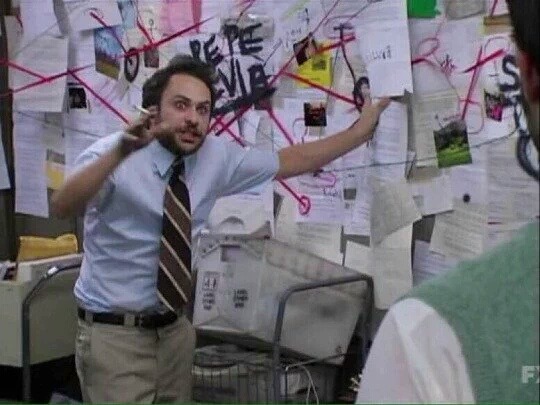
Derrida's Deconstruction
Wait, so does that mean it's futile to try to analyze House of Leaves? Well, sort of, and the book tells us this! Remember that part (see "The Meta") that was giving us advice on how to navigate a maze, i.e. the book? On that same page, p115, it also says:
Unfortunately, the anfractuosity of some labyrinths may actually prohibit a permanent solution. More confounding still, its complexity may exceed the imagination of even the designer. Therefore anyone lost within must recognize that no one, not even a god or an Other, comprehends the entire maze and so therefore can never offer a definitive answer. [In the Navidson house,] any way out remains singular and applicable only to those on that path at that particular time. All solutions then are necessarily personal.
This sounds a lot like Deconstruction and Post-Structuralism, which isn't a coincidence given that Derrida was just quoted on p112. From the Wikipedia page on Deconstruction:
Derrida's deconstruction strategy is also used by postmodernists to locate meaning in a text rather than discover meaning due to the position that it has multiple readings.
It's probably also relevant that most of the book is about Johnny interpreting a text after the literal death of the author.
Footnote 140, which comes after "even the designer" in the above excerpt, includes this, in red and crossed out:
Or in other words: shy from the sky. No answer lies there. It cannot care, especially for what it no longer knows. Treat that place as a thing unto itself, independent of all else, and confront it on those terms. You alone must find the way. No one else can help you. Every way is different. And if you do lose yourself at least take solace in the absolute certainty that you will perish.
This ties the more general advice on interpreting texts back to the specific narratives in HoL. Before we dig into that more in the next section, note that Derrida was also a fan of putting things "under erasure" by crossing them out. Hmm...
Madness and the Minotaur
In multiple ways, the Minotaur is associated with absence. Most obviously, text mentioning it by name usually only appears in red and crossed out--Johnny says these are sections he recovered after Zampanò tried to erase them. The Minotaur also seems to be absent within TNR; the labyrinth of the House suggests its presence through growls and slash marks, but a beast never actually appears, and instead, things within the labyrinth seem to gradually fade out of existence. In myth, of course, the Minotaur was removed from society by hiding it in the labyrinth, and was eventually slain by Theseus, obliterating it forever.
On p335 we get footnote 295, again in red and crossed out:
At the heart of the labyrinth waits the Mi[ ]taur and like the Minotaur of myth its name is [ ] Chiclitz treated the maze as trope for psychic concealment, its excavation resulting in (tragic[ ] reconciliation. But if in Chiclitz's eye the Minotaur was a son imprisoned by a father's shame, is there then to Navidson's eye an equivalent misprision of the [ ] in the depths of that place? And for that matter does there exist a chance to reconcile the not known with the desire for its antithesis?
(The footnote continues, making the shape of a sword with large gaps in the blade.) Empty brackets in this section supposedly denote burnt holes in the manuscript, but since they are consistently used to make puns, it's clear that at least one of the authors is being intentional. We could read the gaps here as literal: the name of the Minotaur is [nothing], the labyrinth conceals the treacherous [nothing] in its depths.
The chapter that footnote appears in (Chapter 13), which is titled The Minotaur, begins with a quote that is translated as so (p313):
a slow shadow spreads across the prairie,
but still, the act of naming it, of guessing
what is its nature and its circumstances
creates a fiction, not a living creature,
not one of those who wander on the earth.
In this poem, El otro tigre, Borges compares a tiger in a poem, made of words and symbols, to "the other tiger" of flesh and blood, out in the wild. No matter how he tries to capture it with writing, the real tiger will always elude him.
So the Minotaur is connected to absence, nothingness, emptiness, and so on. This chapter draws additional associations with death and madness, which of course are also forms of loss or absence--both of self, and of meaning.
Is Johnny the Minotaur?
Johnny is strongly associated with the Minotaur, but his exact relationship with it is more complex than simply "Johnny is the Minotaur" or "the Minotaur represents Johnny". He is stalked by the creature in various forms, and he has nightmares or delusions in which he is the Minotaur. Raymond, the abusive foster dad, calls Johnny "beast". I think it's most accurate to say he is scared of the Minotaur and scared of being or becoming it, especially if we're interpreting it as nothingness or madness. And we know how his story ends.
There's another association I make with Johnny which isn't as explicit and doesn't seem to have been discussed as much, and that is to Icarus. There are hints of this early on--his father is a pilot, he's strongly associated with the sea and drowning, his fantasy when he meets Thumper sounds like flying--but it's brought home in the story about getting the scars on his arms, on page 505, and all the allusions and imagery. He burns and then drowns.
Zampanò, likewise, is like Daedalus. He built the labyrinth that is the manuscript, and which traps both Johnny and himself. There are some suggestions in the text that he and Johnny are like figurative (or in some theories, literal) father and son. But Daedalus, unlike Perilaus, was able to free himself from his own invention, and it seems like this wasn't true for Zampanò.
(This may be too much of a pet theory; I'm not sure it's as well-supported as the other parts of this post. But there's something there, I'm pretty sure.)
House
A house is a structure that defines empty space and imbues it with meaning by separating it from the greater nothingness. The novel is likewise a structure that gives form to a particular nothingness (fiction) by defining it and separating it from the greater nothingness (everything else that has not happened).
As readers, we follow a narrative "thread" through the text, but encounter only the Minotaur (nothingness) within. Just as the Minotaur in Chiclitz's play was portrayed sympathetically, the absence does not need to be bad or monstrous--it's just nothing. As we see in the key shape of footnote 123 (p110-111), the Minotaur is the key, but there is no Minotaur. There is no key. The key is crossed out (both the text comprising it, and the key itself, by being split across two pages). Perhaps we "slay" this Minotaur by imposing our own meaning? Would that be noble or tragic?
The house itself is what matters, but the house is blue, and blue means open to interpretation--what a blue screen meant in the 90s, before digital film became the norm. Everyone projects their own thoughts and fears onto the house, and it reflects those back at them. It's meaning and memory; you get out of it exactly what you bring. Blue is shifting and unfathomable like the sea. You could lose yourself in its depths.
Though "out of the blue" specifically seems more like a deus ex machina, because I'm pretty sure the blue of the sky is associated with God, eyes/cameras/observers, and us (MZD and the readers), though I don't have examples prepared to back that up. "Shy from the sky" (see "Derrida's Deconstruction") could then be taken as "don't look to the author for answers".
But if there is any meaning to be found, it also can't be found looking only within the text and the world it defines, without considering those final layers. The stories all intertwine and even loop back on themselves, as when Navidson and Johnny both encounter their own book. Using the HoL to light your way through HoL will lead nowhere. You'll need help from the outside.
So?
Okay, okay, okay. So what?
"SO?" asks the text (p103), and maybe you do, too. Sew buttons, says the Morse code of footnote 119 on the same page. Dismissing the question? Or suggesting you work hard to secure your buttons with a whole spool of thread, as Johnny does near the end (p514) to avoid losing them to the labyrinth?
Shortly after, on p516, Johnny writes this:
Wasn’t darkness nothingness? Wasn’t that Navidson's discovery? Wasn’t it Zampanò's? Or have I misconstrued it all? Missed the obvious, something still undiscovered waiting there deep within me, outside of me, powerful and extremely patient, unafraid to remain, even though it is and always has been free.
This (and some of his other writing late in the story) reads to me like possibly an acknowledgement or dim awareness of reality outside the book, but I'm not sure. I'm just going to point to it, and also the part a little further down the page, where he describes a sunset as "Reds finally marrying blues."
How do we reconcile red and blue? Is it about reconciling ourselves to the lack of true meaning, as in Nihilism? Or choosing to focus only on the "real", refusing to lose ourselves in the endless cycle of interpretation?
I don't know. There's probably more that can be built on this foundation, but this is as far as I've gotten. If you actually got through all that, wow, thanks for reading, and by all means let me know your own thoughts.
29 notes
·
View notes
Text


—The Return of The King: Appendix A by J. R. R. Tolkien
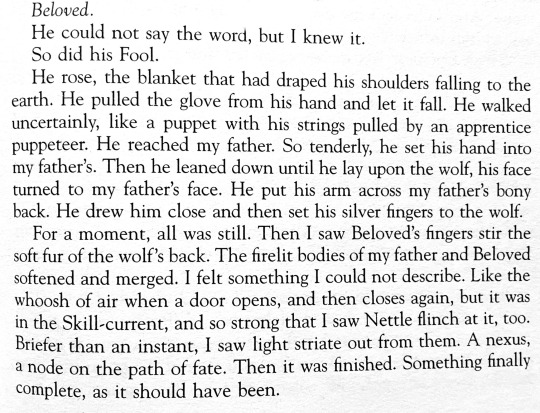
—Assassin’s Fate: Lies and Truths by Robin Hobb
#the lord of the rings#lord of the rings#the return of the king#gimli#legolas#gigolas#jrr tolkien#j r r tolkien#j. r. r. tolkien#tolkien#realm of the elderlings#assassin’s fate#fitzchivalry farseer#beloved#the fool#fitzloved#robin hobb#quotes#webweaving#web weaving#webweave#web weave#rote#rote spoilers#lotr spoilers#my post#no i'm not okay thanks for asking
80 notes
·
View notes